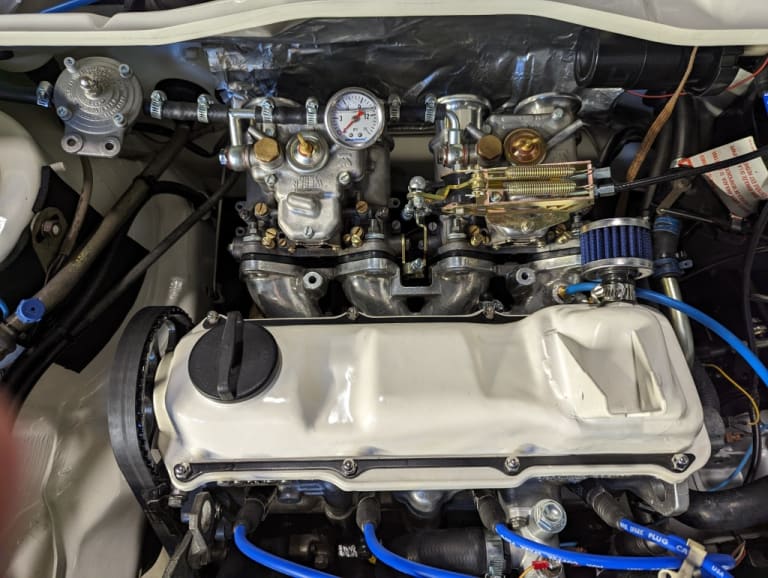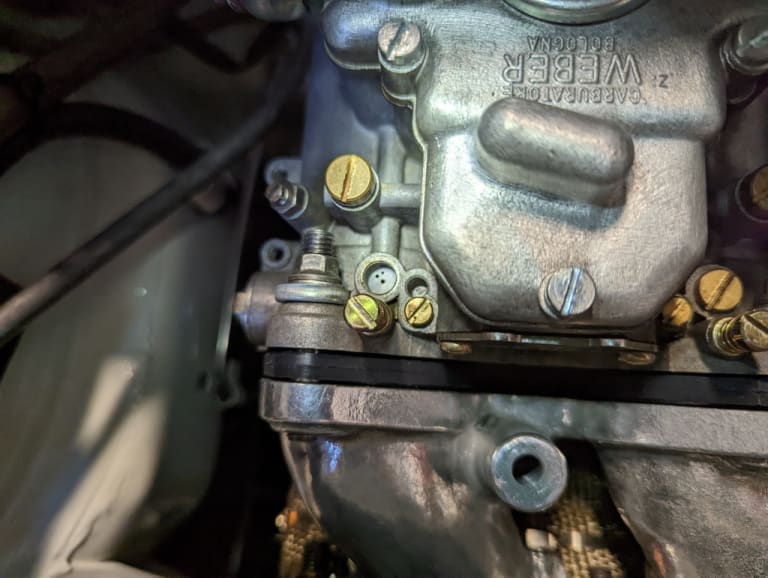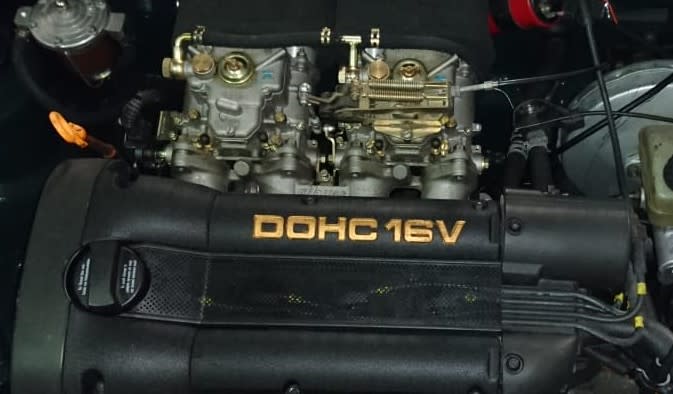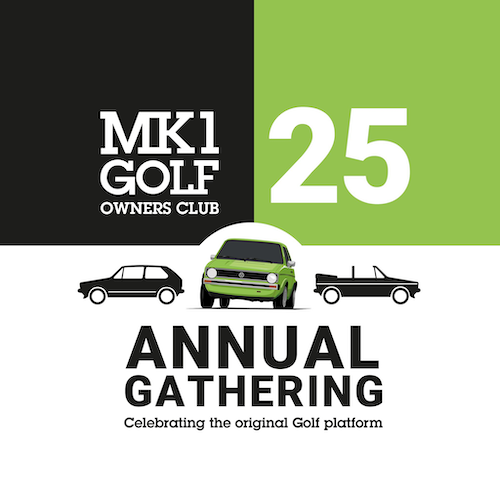Twin Webber 45s, do I need a fuel check valve
Posted
#1662766
(In Topic #237286)
Settled In

Twin Webber 45s, do I need a fuel check valve
Car runs fine on twin Webber 45s but I feel like there's possibly a slight hesitation or something when you put the foot down. Still tuning in the Webber's and trying to eliminate all the peripheral issues before I start on the actual carb tuning /mixtures /airflow alignment etc
So I have carbs setup with malpassi regulator set at 3psi. The regulator is litterly right before the carbs so I'm wondering if it can't regulate the pressure so well as it could say further back in the line?? Possibly not enough fuel accumulation in the line?
Also when car is shut off the fuel line drains back to the pump so the visual fuel filter in the engine bay kind of empties a little. So I thought about adding a check valve at the output of the pump on the rear quarter. When you come to start the car you have to prime the pump several times to fill the fuel line and she starts no prob so my thinking is if I add the check valve I won't have this issue.
Also, Was just wondering if anybody who is running carbs (original) or aftermarket has any info on the fuel setup for their cars. Does the original carb setup have a check valve, swirl pot, fuel accumulator etc in their fuel systems?
Mk1 VW 1989 Cabriolet (Clipper Kit) in restoration
Mk1 VW 1986 Cabriolet Wolfsburg Triple White (in queue)
Ford Escort RS Turbo, Wide Body (in queue for restoration)
Roush Mustang 485BHP 4.6L Supercharged Blackjack
Mk1 VW 1986 Cabriolet Wolfsburg Triple White (in queue)
Ford Escort RS Turbo, Wide Body (in queue for restoration)
Roush Mustang 485BHP 4.6L Supercharged Blackjack
Posted
Settled In

Interestingly........... while I was looking into this issue i noticed that one barrel of my webber setup was missing a vacuum port plug. So that could account for the low idle and stalling issue i have. Also even better was the fact i swept the shop the other day so went digging around the piles to see if i could find it and whoooo hooooo! Found my missing vacuum plug in the sweeping pile! So its a small win so i'll take it right now with all the other issues i got.
Also, on the regulator issue, i discussed that with David also and he said it "shouldnt" really be an issue but would "probably" be better off having the regulator set further back from the carbs probably somewhere around where my visual fuel filter is located. Im going to install my missing vacuum plug and see if that corrects the issue first, and if not will look to move my regulator further away from the carbs.
Also, for bonus points...... i dint know these carbs have vacuum ports so now i can tune with the vacuum gauge setup instead of the flow meter i have because its tight against the bulkhead. And also can make up a 4 branch vacuum line for the distributor and the brake servo instead of having it come off just one cylinder, cylinder 4 because of the inlet manifold taps. So will see how that goes also. May or may not be needed dont know yet.
Mk1 VW 1989 Cabriolet (Clipper Kit) in restoration
Mk1 VW 1986 Cabriolet Wolfsburg Triple White (in queue)
Ford Escort RS Turbo, Wide Body (in queue for restoration)
Roush Mustang 485BHP 4.6L Supercharged Blackjack
Mk1 VW 1986 Cabriolet Wolfsburg Triple White (in queue)
Ford Escort RS Turbo, Wide Body (in queue for restoration)
Roush Mustang 485BHP 4.6L Supercharged Blackjack
Posted
Settled In

Either way, if you need some assistance let me know. I can explain what bits do what and when but they all effect each other. It's like balancing spinning plates on other spinning plates. I'd like to know what engine, which variant of the 45s, timing settings, current jetting (all), what size chokes, etc… If you don't have a wideband O2 sensor to monitor it's almost a lost cause. You can get to run good but it'll likely be to rich, washing the oil of the cylinder walls and eating your rings rather quickly.
See my videos, Tom AFH
Posted
Settled In

 Nedrager, thanks for chiming in, yeah I have had limited success with read the Webber book, its good for strip down and repair but not so much tuning. Also found limited info online but found few videos on YouTube for basic settings and then tuning with airflow meter thing. The problem is the airflow meter is it's not that accurate and really tight for my setup as the 45s face the firewall.
Nedrager, thanks for chiming in, yeah I have had limited success with read the Webber book, its good for strip down and repair but not so much tuning. Also found limited info online but found few videos on YouTube for basic settings and then tuning with airflow meter thing. The problem is the airflow meter is it's not that accurate and really tight for my setup as the 45s face the firewall.I'll give you a list of all my parts and bits and bobbles, a be little later today when I get to the shop. Any help or input would absolutely be appreciated 👍
The biggest problem seem to have right now seems to be getting the fuel pressure to say at the regulated 3psi. Seems ok on one startup then it's 4psi on next startup and then 2psi on the startup after. I still think I need to move my pressure regulator further upstream of the carbs like I mentioned previously because there isn't enough volume between the regulator and carbs to maintain the 3psi……but I've not moved it yet.
Update: Photo of my setup, Twin Webber DCOE 45 152
Car is JH engine block bored out 1mm (not really for the extra more so because the cylinders were scored), its cammed with TT 276 cam and got 4/2/1 headers with TT 2.25" exhaust.
Twin Webbers are running the below jets.
36mm Chokes
165 Main
190 Air
65 F8 Idle
0 Bypass
F16 E-tube
30mm Air horns
 Last edit: by Shubbs
Last edit: by Shubbs
Mk1 VW 1989 Cabriolet (Clipper Kit) in restoration
Mk1 VW 1986 Cabriolet Wolfsburg Triple White (in queue)
Ford Escort RS Turbo, Wide Body (in queue for restoration)
Roush Mustang 485BHP 4.6L Supercharged Blackjack
Mk1 VW 1986 Cabriolet Wolfsburg Triple White (in queue)
Ford Escort RS Turbo, Wide Body (in queue for restoration)
Roush Mustang 485BHP 4.6L Supercharged Blackjack
Posted
Settled In

1. What engine?
Sounds like an 8V if you have no room in front of the velocity stack.
2. What model 45s do you have?
Something older? or newer like 152? 152G (if so, how many progession holes, 3,4,50? They tune a bit diffently
Note:
If you have newer 45s with the vacuum ports, capped near the idle air adjustment, I'd recommend buying nipples that screw in there and some caps. It makes syncing much easier. I also have a 4 port vacuum gauge typically used on motorcycles so I can see all levels concurrently.
I'd also recommend measuring, somehow, the distance from your intake valve face out to the end of the velocity stack. You have to measure through the carb body and manifold. with this meausrement, choke diameter, desired hp peak rpm, and your cam duration it's possible to calculate intake resonance. You may need to chance the stacks to dial it in. It's definately not as simple as short ones for high rpm and long ones for low rpm. If you get this right it makes having Webers worth it. Gains of 10%, 7%, and 4% are possible if you hit the 2nd 3rd or 4th harmonic. It's not likey you'll hit the 2nd, but possibly either or both of the others. I've been able to hit the 3rd and 4th with peak power above 7000 rpm.
This is likely unrealistic for most, but the 4th is down lower in the 4500-5500 range. It makes a differnce and effects the jetting across the entire rpm range so it's worth looking at.
See my videos, Tom AFH
Posted
Settled In

I have both 62mm and 30mm Air horns. Will try to get a measurement on intake length.
Both carbs have 3 progression holes on each barrel.


 Last edit: by Shubbs
Last edit: by Shubbs
Mk1 VW 1989 Cabriolet (Clipper Kit) in restoration
Mk1 VW 1986 Cabriolet Wolfsburg Triple White (in queue)
Ford Escort RS Turbo, Wide Body (in queue for restoration)
Roush Mustang 485BHP 4.6L Supercharged Blackjack
Mk1 VW 1986 Cabriolet Wolfsburg Triple White (in queue)
Ford Escort RS Turbo, Wide Body (in queue for restoration)
Roush Mustang 485BHP 4.6L Supercharged Blackjack
Posted
Settled In

If anybody has a head sitting around they could measure the inlet port that would be super helpful for me. 8 valve counter flow head.
Mk1 VW 1989 Cabriolet (Clipper Kit) in restoration
Mk1 VW 1986 Cabriolet Wolfsburg Triple White (in queue)
Ford Escort RS Turbo, Wide Body (in queue for restoration)
Roush Mustang 485BHP 4.6L Supercharged Blackjack
Mk1 VW 1986 Cabriolet Wolfsburg Triple White (in queue)
Ford Escort RS Turbo, Wide Body (in queue for restoration)
Roush Mustang 485BHP 4.6L Supercharged Blackjack
Posted
Settled In

You can also use the blanking cap from an IDF carb where your cold start mechanism was. Just a cover but looks better.
I run a self regulating Huco pump, 2.1psi, they're cheap and good to about 160bhp. I think fuel pressure between 2 and 4 isn't going to be an issue.
You'll have more headaches with float levels and tuning through transitions…
I didn't catch if you have a wideband or not?

See my videos, Tom AFH
Posted
Settled In

Yeah I deleted the cold start chokes, kept them obviously but not running them. Here in Houston it pretty warm almost all year round so no real need for them so I deleted them and put on the Webber blanking plates.
I like your setup on the 16valver too, that's nice!
Yeah I was planning on hooking up the vacuum ports to the brake servo and also the ac pods (vacuum operated air intakes for the ac) it's get pretty hot coke summer time here so I kept the ac system. Lol right now I have two vacuum port on the manifold also, but they are only from cylinder 4. Not all cylinders like the carb vacuum ports. But I also have blanking caps if needed too.
 Last edit: by Shubbs
Last edit: by Shubbs
Mk1 VW 1989 Cabriolet (Clipper Kit) in restoration
Mk1 VW 1986 Cabriolet Wolfsburg Triple White (in queue)
Ford Escort RS Turbo, Wide Body (in queue for restoration)
Roush Mustang 485BHP 4.6L Supercharged Blackjack
Mk1 VW 1986 Cabriolet Wolfsburg Triple White (in queue)
Ford Escort RS Turbo, Wide Body (in queue for restoration)
Roush Mustang 485BHP 4.6L Supercharged Blackjack
Posted
Settled In

pressure switch and relays. I didn't want to drag down a single cylinder. Lots of check valves too so if a pump fails the brakes will still work.
You'll want a wideband, something decent. AEM, Autometer, etc. I'd say go browse around on Amazon or summitracing.com and find one that fits your budget. I think any that come with a Bosch 4.9 sensor will do fine.
 Last edit: by nedrager
Last edit: by nedrager
See my videos, Tom AFH
Posted
Settled In

Also something I should also maybe mention is my distributor is the vacuum advance version also.
I kind of thought about the separate vacuum pumps also but wasn't too sure how to integrate the brake servo and distributor. Might have to go to a mechanical version perhaps.
Mk1 VW 1989 Cabriolet (Clipper Kit) in restoration
Mk1 VW 1986 Cabriolet Wolfsburg Triple White (in queue)
Ford Escort RS Turbo, Wide Body (in queue for restoration)
Roush Mustang 485BHP 4.6L Supercharged Blackjack
Mk1 VW 1986 Cabriolet Wolfsburg Triple White (in queue)
Ford Escort RS Turbo, Wide Body (in queue for restoration)
Roush Mustang 485BHP 4.6L Supercharged Blackjack
Posted
Settled In

Running on the mechanical advance alone will work.
You'll typically want to run more timing at idle with Webers, around 10-12 degrees advance.
The total timing will depend on the engine and it's architecture. I'd guess somewhere between 29 and 33 degrees with your setup, depending on compression ratio. You'll have to find what works without the engine knocking.
You can set idle to 10 degrees then rev the motor over 3000rpm and see how much advance you gain. Typically there's about 25 degree mechanical advance built in. You should see 35 total if that's the case.
See my videos, Tom AFH
Posted
Local Hero

Where as it should route like this from Cabby-info.com

What little I know about Vacuums in a VW is related to my 81 Diesel Golf, or my 90's Digifant with EFI. Ok the Diesel had a Vacuum pump that operated the heater controls and Brakes. Funny thing is that I never knew I had a vacuum issue on my Golf until my heater controls wouldn't go full frontal, as I didn't notice the lack of firm brakes first, but after rebuilding the Pump, the breaks worked really really good. LOLOL
But from my Carb days especially on my 76 Toyotas, a small leak in the Vacuum hoses would cause a myriad of crummy running, so much so that I usually would clip the ends off of the Vacuum lines about every 5 months and when they got too short I would replace them.
Not that I had too many issues when I upgraded the OEM hoses to Gates, on my Rover 3500S. (Loved that car, and after 44 years I still miss it…
What do Divorces, Great Coffee, and Car Electrics all have in common?
They all start with GOOD Grounds.
Where are my DIY Links?
They all start with GOOD Grounds.
Where are my DIY Links?
Posted
Settled In

I set the ignition timing to 10degress advance based on what TechtonicsTuning advised for their cam that's in the car TT276. They also advised total timing should be somewhere in the 28 to 32 degrees region which is pretty much what you said also.
I was thinking of using the vacuum ports on the Webber's to manifold together and run that to the distributor. But is it required? If not then I won't do it, just not sure what I need in place of that? Or do I not need anything in place of that? When you say running on mechanical advance alone is that purely what I set the ignition timing to? Ie the 10 degrees and then engine will advance with the revs, WITHOUT the vacuum port on the distributor? Also, How do I go about identifying the total mechanical advance?
Briano1234, yeah thanks for the info man. Been looking at the large diameter pipe on the brake servo. Ideally I think I would separate it and the ac controls etc and have separate vacuum pump same as Negrader so the systems are not dependant on engine vacuum and then run them like that if I can. Would be easier setup that the varies vacuum pull from the carb manifold or the carbs themselves. Also from a carb tuning perspective I think it would be simpler also. But would need Negraders input there as I have no idea how to do that.
Mk1 VW 1989 Cabriolet (Clipper Kit) in restoration
Mk1 VW 1986 Cabriolet Wolfsburg Triple White (in queue)
Ford Escort RS Turbo, Wide Body (in queue for restoration)
Roush Mustang 485BHP 4.6L Supercharged Blackjack
Mk1 VW 1986 Cabriolet Wolfsburg Triple White (in queue)
Ford Escort RS Turbo, Wide Body (in queue for restoration)
Roush Mustang 485BHP 4.6L Supercharged Blackjack
Posted
Settled In

Shubbs said
1.
..But is it required? If not then I won't do it, just not sure what I need in place of that?
2.
Also, How do I go about identifying the total mechanical advance?
1.
Short answer, No. Cap the port at the manifold. Vacuum advance is not required. Vacuum advance is something that comes in addition to mechanical advance. No motors distributor is purely vacuum advanced. It's used for light loads and fuel efficiency.
Note: With Webers you have to choose between efficiency, power and driveability. You can have maybe 2 out of 3 but not all… unless you run a more complex ignition setup than what you have. But this makes tuning harder overall because Webers are very sensitive to timing changes.
2.
If you have a timing light, preferably one with adjustable advance, you'll be able to figure out the total advance available from the mechanical advance built into the distributor. If you set your timing light to say 30 degrees advance, rev the motor to 3000-3500 rpm, point the light at your timing mark. If you had 30 degrees total timing then your timing marks will line up at the TDC mark.
Otherwise there may be alternative marks at different advance degrees on your motor or pulleys.
This is something you'll have to research for your specific motor and setup.
I can help you setup an alternate way to provide vacuum for the brakes and whatever else you need but you'll need at least one vacuum pump with a mount, a reservoir, adjustable vacuum switch, several check valves, a power relay and power source for the pump
See my videos, Tom AFH
Posted
Settled In

1.
Ok so I'm gonna cap the vacuum ports on the manifold that are at cylinder 4. And I assume I also cap the vacuum advance port on the distributor Just to keep dirt and stuff out of there?
Power and driveability would probably be the two I would go for fuel efficiency not so much for this car.
2.
Yeah I have an adjustable timing light. So when engine is at idle I see the 10 degrees mark I made on the flywheel before TDC with the light pointed at the hole in the gearbox.
So on total timing, mechanical advance, if I hold the revs as 3000 to 3500 what should I see? I assume I won't see TDC mark because it should now be further from TDC….which will also be past my 10degrees mark on the flywheel so if I have nothing marked on the flywheel I will just randomly see a point on the flywheel? How do I correlate what the mechanical advance of the distributor is against a point on the flywheel, surely I need to know one or the other before I can test it? Or do I hold revs up and physically see how much advance is generated on the flywheel while I'm flashing at 10 degrees then measure that differential distance on the flywheel from at idle to 3500rmp Then add that distance to my 10degrees?
I'm a bit confused how to find the mechanical advance if I don't already know it? I assume once I get that distance of advance I can mark the flywheel then run up the light with varying degrees until I find the correct degree of advance that matches the new mark I made on the flywheel? Is that correct?
Nothing is marked on my flywheel or pulleys except TDC on the pulleys and the flywheel and then the 6°BTDC and also a 10°TDC mark I made by calculating the distance. Think its 6° every 12mm on my flywheel so my 10° mark is at 20mm from TDC.
Yeah whatever info you have on the alternative vacuum setup for brakes and my ac I would be keen to see that to find out everything that's involved and get a better understanding of how much modification I would need to do to install etc.
UPDATE: I was messing with the car a little bit tonight, I capped all the vacuum ports on the carbs and the distributor and I came across another question for you. My neighbor and I were discussing the wierd fuel pressure issue, (it just won't regulate properly, always seems to kind of hunt around, like 2psi then 3psi then 5psi and so forth.) So long story short, I have the in tank lift pump and the Webber redline external pump. And my neighbor suggested testing both pumps to make sure they are working correctly. So I disconnected the intank lift pump just to run the external pump and hey presto……now fuel line is a rock solid 3psi doesn't shift from that. So the question is what is your fuel setup? Are you using both intank lift pump and external pump or only external? It seems like my intank lift pump was affecting my external pump somehow. So car now runs a lot better with all vacuum lines capped and no vacuum advance AND only using the Webber pump. Intank lift pump is disconnected.
 Last edit: by Shubbs
Last edit: by Shubbs
Mk1 VW 1989 Cabriolet (Clipper Kit) in restoration
Mk1 VW 1986 Cabriolet Wolfsburg Triple White (in queue)
Ford Escort RS Turbo, Wide Body (in queue for restoration)
Roush Mustang 485BHP 4.6L Supercharged Blackjack
Mk1 VW 1986 Cabriolet Wolfsburg Triple White (in queue)
Ford Escort RS Turbo, Wide Body (in queue for restoration)
Roush Mustang 485BHP 4.6L Supercharged Blackjack
Posted
Settled In

2. I've covered that in previous posts. If you have an adjustable timing light then set it to 10 degrees. At idle you will see the TDC marks line up if the engine timing is set to 10 degrees advance.
If you set the timing light to around 30-35 degrees, rev the motor to around 3000-3500rpm you should see the TDC marks line up. This represents the 10 degrees at idle plus the 20-25 degrees mechanical advance built into the distributor for 30-35 total advance.
My car was originally a carbureted with a mechanical pump on the motor. I didn't have any electrical fuel pumps from the factory.
See my videos, Tom AFH
Posted
Settled In

Mk1 VW 1989 Cabriolet (Clipper Kit) in restoration
Mk1 VW 1986 Cabriolet Wolfsburg Triple White (in queue)
Ford Escort RS Turbo, Wide Body (in queue for restoration)
Roush Mustang 485BHP 4.6L Supercharged Blackjack
Mk1 VW 1986 Cabriolet Wolfsburg Triple White (in queue)
Ford Escort RS Turbo, Wide Body (in queue for restoration)
Roush Mustang 485BHP 4.6L Supercharged Blackjack
Posted
Settled In

After that I got darn tired of the carbs not working I pulled them off and did some fault finding. Low and behold after I pulled them off it was clear that I had installed one choke backwards, you couldn't see when installed because it was facing the firewall, but when whole carb removed, and you look down the barrels it stuck out like a sore thumb. After that I pulled the accelerator jets and wouldn't you know it two jets were clogged with some tiny bits of dirt. Blew them out and reinstalled everything.
Car starts right up first crank, pulls nicely and sounds amazing when revving her up. All in all pretty happy with that.
Mk1 VW 1989 Cabriolet (Clipper Kit) in restoration
Mk1 VW 1986 Cabriolet Wolfsburg Triple White (in queue)
Ford Escort RS Turbo, Wide Body (in queue for restoration)
Roush Mustang 485BHP 4.6L Supercharged Blackjack
Mk1 VW 1986 Cabriolet Wolfsburg Triple White (in queue)
Ford Escort RS Turbo, Wide Body (in queue for restoration)
Roush Mustang 485BHP 4.6L Supercharged Blackjack
0 guests and 0 members have just viewed this: None.










